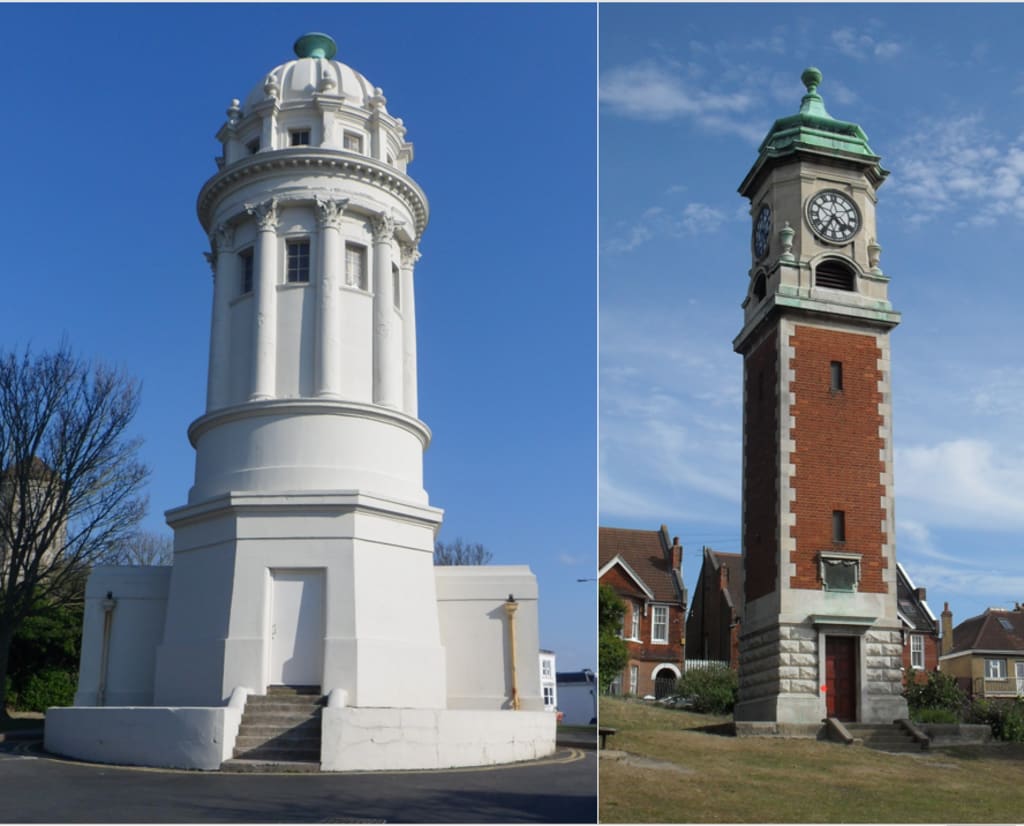Two Towers;
Or, Anecdotal Evidence On Memories in Monuments

There is a MUJI 無印良品 aroma diffuser glowing at my windowsill. Steam; not smoke. Still, candlelike. It is upright and warm and holds memories of Christmas.
Rain taps my window and droplets lick the glass. Outside is verdant, wetted, and vibrant: healthy in that green way gardens can be. I wonder at the drizzle, the leering fists of fog that fold between the branches and seep through gaps between fence-panels. My gaze is drawn away from the oiled keys at from my fingertips, and out, until I see that puddle. It is an ephemeral pool. It gurgles under storms and fades under suns. It is there now, and shimmering a little, just shaded by the overgrowing buddleia. Every seven seconds or so a raindrop splashes into it, warping the surface. That shimmer, a weft.
But behind me, behind my back, our house, is a greater, greener, grander place. A public park in Brighton, England:
In 1825, Thomas Attree, a property owner and developer in Brighton, acquired land north of Eastern Road—already known as Brighton Park—to build a residential park surrounded by detached villas, inspired by Regent’s Park in London. [1]
[…] Also to the north-west of the park itself, on Queen’s Park Road, stands the Pepper Pot (also called the “Pepper Box” [citation needed]). Probably originally built as a horizontal wind-powered water pump, and later used for the publishing of a local newspaper, it was later an artist’s studio and by the 1990s a public convenience. [2]
Attree’s plan never fully materialised and the surrounding housing is mostly late Victorian with some late 20th century infill and replacement. [3]
Wikipedia is remiss not to note the second tower. It watches over Attree’s failed microcosm of Regent’s Park in London from within. It has four faces and is a Clocktower. Two towers. Monuments protecting places and housing many things, and memories.
Each tower dominates its own hill. One a hard, grey hill; the domain of pepper and once-maybe water-pumping is tarmac. The other is green in our rain, made soft mud under saturation; the domain of the time-teller is grassland. Both watch over the Queen’s Park valley between them. The first is whitewashed and pillared and smooth and round. Neoclassical and ordered. The other is less phallic, stern, sans the columns or curved sides. Frankish, stark. Both have little verdigris caps and cement stairs. The Pepperpot has double the steps. The Clocktower is longer.
Apparently the Pepperpot housed many different people until it was sealed. I’ve heard they’re going to turn it into a library. Its entryway changes and it is given new uses and users. So standing before its ten steps gives me no wonder. It is a well-documented watershed and the lesser of the two towers, inside the memories of others, protecting a time before.
At the foot of the Clocktower is a wooden door. We used to think coven-cults of satans and the souls of dead bellringers congregated inside. That the graffiti were messages they left us. I still do not know who has the key. Who watches the watcher? Who checks the chimer? No one at all, so far as I know.
For seven years I spent every day between them. Blue skies and grey. That childish simplicity, maybe nostalgia. Wandering around there now is different but with a lot retained. Glasses and train journeys have since swept past, beyond the torn trousers and tragicomedies. I mean to say my granddad died before he saw our park but I got to bring my baby sister there in the young summers when she cycled and smiled more. Those two towers had remained, and in spite of the felled trees and forgotten friendships, helped me remember.
Our park had many puddles of its own, I think. I did not count more than the pond, where the geese and the ducks bobbed. An island was in the middle, a place I had always wanted to wade through the three inches and visit. They’d built a new jetty, for no reason, but it drew me a little closer to Pond Isle. A big old elm leaned over it. Queen’s Park, like Regent’s Park in London, has lots of trees. You notice that when they’re gone, or the pollarding is bad, like it is now. I rustled my hand over my head: I had just cut my own hair two days ago.
Maybe this is a memoir on the merits of rain. But I wander between two towers alone now, wondering where time best falls, whilst space is held up. Scattered memories.
A dog chased me on that slope. I used to run from them when they broke through the hound bars segregating them off from us. Scared as a rabbit in plain sight. They never bit me.
I was conscripted to play football on that sparsely grassed hill. At the bottom is a tree that has always been wiry, a beanpole man. At the top is a tree that has always been broad, his big brother. Neither grew much. I was conscripted to play football but all I really did was pretend I was a commentator, screaming out the goings-on: children miskicking and slide-tackling through dust; pitch-length goals (the slope is shorter than a penalty box) and snot-lipped brawls. How I managed my career with any confidence is impressive: it was two years after I’d stopped my commentary duties I finally listened to my first game of professional football. Five years or five months after that, those conscription officers—friends—forced me to play keeper for the new primary school football team. We trained in the shadow of the Clocktower. We lost every game.
I was meant to get the bus from the Pepperpot stop. I was ten, or maybe eleven, and I wandered through Queen’s Park, past the Clocktower. But I had the Saturday morning to practise my bad football before we left. During my training session, my friends were hiding in the foliage around Queen’s Park. It was a joke, that they would never come out. They texted me whilst they watched and told me to get going. I walked to town alone. The Clocktower saw it all.
We remember minor things because our mind stores them in real places. Memories in Monuments. [4] You see them and know, not just remember. Maybe it is in their shape.
I hear a fox in the brush beside me. They are bolder now. They used to hide in the holes in gardens. Not so, not anymore. We wanted them healthy because it is sadder to see them starve than see rubbish rolling down hills. And as the rain simmers out to stop, I am returned home.
Endnotes:
[1] So Wikipedia's Queen's Park article has said, 2:1-2.
[2] Ibid., 3:1-3; the term “Pepper Box” is unfamiliar to local residents, some of whom have been here their entire lives. Like all of the selected excerpts, this statement is unreferenced. The origin of the synonym remains known only to the Wikipedia author. My parents, Jackie (Lila) and Jon think even if they once knew, it wasn’t worth remembering. Whatever a “public convenience” is remains a mystery for later.
[3] Ibid., 2:5-6. My understanding of architecture is casual but our house is Edwardian. Or so I’ve been told.
[4] An idea studied by Kulišić Marija and Miroslav Tuđman in, ‘Monument as a Form of Collective Memory and Public Knowledge’, 2009.





Comments
There are no comments for this story
Be the first to respond and start the conversation.